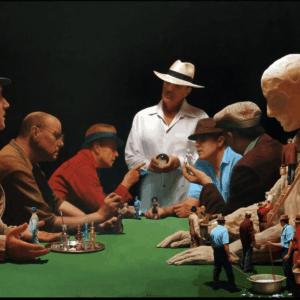James Mooney, a self-taught artist, was born in Kidderminster, England, in February 1944. Leaving school at the age of fifteen to pursue an electrical apprenticeship, Mooney’s early years were defined by hard work and the pursuit of various business ventures. In 1966, he emigrated to South Africa with his family and settled in Cape Town, where he started multiple businesses before embarking on a journey that took him to Australia and back to England. In the early 1980s, Mooney returned to South Africa, where he has remained ever since.
Artistic Beginnings and Development
Mooney’s love for art was sparked in 1972, but it wasn’t until the early 1980s that he started painting seriously. Working primarily in oil on board, Mooney’s paintings span a broad range of subjects, from miniature forest scenes and landscapes to conceptual works and portraits. His versatility as an artist shines through in his ability to move seamlessly between styles and subjects, reflecting the boundless potential of human imagination when freed from constraint.
Mooney’s breakthrough came with his first one-man exhibition, “Beyond Reason,” held at the 1820 Monument in Grahamstown in 1991. His notable piece, “Portrait of James Joyce,” was selected for the 1991 Cape Town Triennial and acquired by the King George VI Gallery in Port Elizabeth.
Portraits and Style
Over the last few decades, Mooney has produced an impressive body of work, including fifteen composite portraits of cultural icons such as Thomas Mann, Oscar Wilde, Marilyn Monroe, and James Joyce. These portraits reflect his recurring obsession with history and memory and incorporate miniatures spanning multiple genres, including realism and abstract expressionism. His work captures the psychological complexity of his subjects and himself, with Mooney often turning to self-portraits in his later career, exploring the idea that all portraits are autobiographical through the lens of the artist’s perception.
A hallmark of Mooney’s work is his innovative “vibrato” technique, which he developed to create monochromatic miniatures. This technique involves seemingly random marks that coalesce into evocative images—such as vast medieval armies or surreal scenes—adding a mystical quality to his art.
Themes and Evolution
While Mooney is well-known for his small figurative works, depicting nymphs in the forests of Knysna and women along the shoreline, his subject matter evolved over time. He shifted towards more urban, figurative works that often explored eroticism and mystery, with his focus on creating tension and dialogue between subjects, inviting viewers to fill in narrative gaps.
Mooney’s interest in history, memory, and the complexity of the human psyche is evident throughout his diverse body of work. His paintings are not only reflections of his personal fascinations but are also a tribute to the endless possibilities of artistic expression.
Retrospective and Recognition
Despite his reclusive nature, Mooney’s work has been widely appreciated within the art community. In 2005, the Everard Read Gallery in Cape Town held a retrospective exhibition titled “…a Grain of Sand,” which showcased the depth and range of his artistic journey. Though he has eschewed the limelight and declined solo exhibitions over the years due to the meticulous nature of his work, Mooney’s contributions to South African art have left a lasting impact.
Beyond painting, Mooney is a writer of poetry and short stories, none of which have been published, and has an avid interest in science, particularly astrology. His curiosity and commitment to exploration—both in art and life—are reflected in his diverse and ever-evolving creative output.
James Mooney continues to inspire with his intricate, emotionally resonant work that pushes the boundaries of artistic convention while delving deep into the human experience

